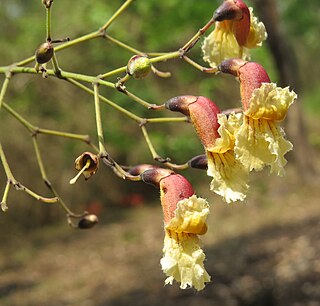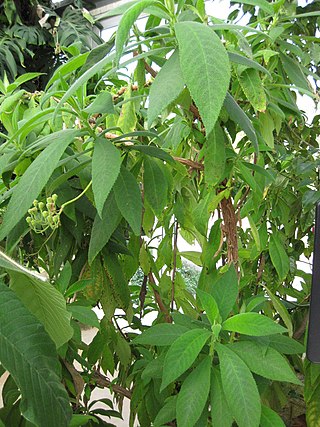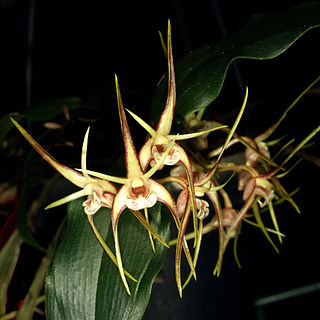
Gentianaceae is a family of flowering plants of 103 genera and about 1600 species.

Epilobium is a genus of flowering plants in the family Onagraceae, containing about 197 species. The genus has a worldwide distribution. It is most prevalent in the subarctic, temperate and subantarctic regions, whereas in the subtropics and tropics Epilobium species are restricted to the cool montane biomes, such as the New Guinea Highlands.

Stereospermum tetragonum, the yellow snake tree, is 15–20 m tall, trunk 15–25 cm in diam, large leaves 25–50 cm; leaflets 3–6 on each side of midrib, long elliptic, 8-14 X 2.5–6 cm. Large, pale yellow, trumpet shaped flowers occur in panicles. Flowers are pale yellow, slightly curved, about 2 cm, upper lip 2-lobed, lower lip 3-lobed, tomentose at mouth, tube terete. The fruit is long, 4-angular, slightly curved, 30–70 cm, about 1 cm in diameter. This, probably, is the source of its common name, snake tree.

Stereospermum is a genus of trees in the paleotropical clade of the family Bignoniaceae. A species of Stereospermum is used in herbal medicine in Ayurveda as well as it is an integral part of the culture and tradition of the cold desert biosphere reserve.
Spider orchid typically refers to the orchid genus Caladenia as a whole.

Alloplectus is a genus of Neotropical plants in the family Gesneriaceae. A recent revision of the genus includes five species, with the majority of species in the genus as traditionally circumscribed being transferred to Crantzia, Glossoloma, and Drymonia.

Exacum affine, known commercially as the Persian violet, is a species of plant in the family Gentianaceae. It is endemic to Socotra, part of Yemen, though its popularity and cultivation around the world have made it an occasional greenhouse weed. Its natural habitat is rocky areas. This is a small herbaceous biennial plant with dark green, ovate leaves. The small purple flowers have a yellow centre with fragrance.

Exacum is a genus of plant in family Gentianaceae. It contains the following species :
Exacum caeruleum is a species of plant in the Gentianaceae family. It is endemic to Yemen. Its natural habitat is subtropical or tropical dry shrubland.

Dendrobium tetragonum, commonly known as the tree spider orchid, is a variable species of epiphytic or lithophytic orchid endemic to eastern Australia. Tree spider orchids are unusual in having pendulous pseudobulbs that are thin and wiry near the base then expand into a fleshy, four-sided upper section before tapering at the tip. There are only a few thin but leathery leaves at the end of the pseudobulbs and up to five flowers on relatively short flowering stems. To allow for the variations in the species there are five subspecies and a variety, some with a unique common name.

Eranthemum is a genus of plants in the family Acanthaceae.

Exaceae is a flowering plant tribe in the family Gentianaceae. Exaceae comprises about 180 species assigned to eight monophyletic genera, with major centres of endemism in continental Africa, Madagascar and the southern tip of India and Sri Lanka (14 endemic species).
Cosmarium tetragonum is a species of green algae in the family Desmidiaceae. It is a freshwater species with a worldwide distribution.

Epilobium tetragonum, commonly known as the square stalked willow herb, is a species of flowering plant in the willowherb family Onagraceae.

Mitreola sessilifolia, commonly known as swamp hornpod, is a species of small flowering plant in the genus Mitreola in the family Loganiaceae. The plant is native to the southeastern United States, but can be found as far west as Arizona. It was previously included in the genus Cynoctonum.It is also considered a facultative wetland species (FACW), which makes it an indicator species for wetlands, but may occur in non-wetland areas as well.

Mitreola, commonly known as hornpod, is a genus of small flowering plants consisting of approximately 13 species in the family Loganiaceae. They are herbaceous perennial plants found in tropical, subtropical, and temperate regions of Africa, Asia, Oceana and the southeastern United States. Some species were previously included in the genus Cynoctonum. Most species are less than a 12" tall, have sessile leaves, and small white flowers.

Exacum travancoricum is one of the rare and threatened plants of western Ghats. It comes under family Gentianaceae. Moderately to much branched usually laxly cushion-like herb with elliptic, somewhat succulent leaves and usually solitary terminal pale blue to blue flowers. Endemic to Southern Western Ghats at 950-1800m. Flowers during July - November.

Limonium tetragonum, the square-stalked sea lavender, is a species of flowering plant in the family Plumbaginaceae. It is native to Primorsky Krai in Russia, South Korea, central and southern Japan, the northern Ryukyu Islands, and New Caledonia some 6,800 km (4,200 mi) away. A biennial halophyte, it can be found growing at the high tide line in coastal wetlands and in salt marshes. It is collected in the wild and eaten as a vegetable, and is considered to have medicinal properties. There appears to be an ornamental cultivar, 'Confetti'.

















